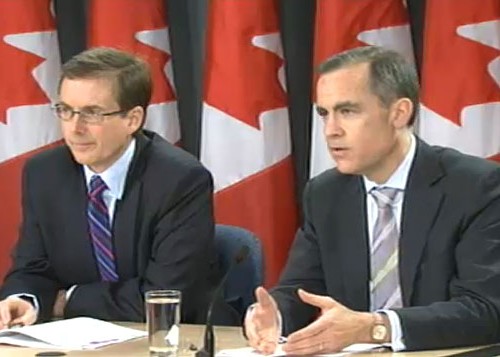Release of the Monetary Policy Report
Available as:
PDF
Good morning. Tiff and I are pleased to be here with you today to discuss the January Monetary Policy Report, which the Bank published this morning.
- The global economic recovery is proceeding at a somewhat faster pace than the Bank had anticipated, although risks remain elevated. Private domestic demand in the United States has picked up and will be reinforced by recently announced monetary and fiscal stimulus.
- European growth has also been slightly stronger than anticipated. However, ongoing challenges associated with sovereign and bank balance sheets will limit the pace of the European recovery and are a significant source of uncertainty to the global outlook.
- Some emerging markets have begun to implement more restrictive policy measures in response to overheating in their economies. The effectiveness of these policies will influence the path of commodity prices, which have increased significantly since October.
- The recovery in Canada is proceeding broadly as anticipated, with a period of more modest growth and the beginning of the expected rebalancing of demand. The contribution of government spending is expected to wind down this year, consistent with announced fiscal plans. Stretched household balance sheets are expected to restrain the pace of consumption growth and residential investment.
- In contrast, business investment will likely continue to rebound strongly, owing to stimulative financial conditions and competitive imperatives. Net exports are projected to contribute more to growth going forward, supported by stronger U.S. activity and global demand for commodities.
- However, the cumulative effects of the persistent strength in the Canadian dollar and Canada’s poor relative productivity performance are restraining this recovery in net exports and contributing to a widening of Canada’s current account deficit to a 20-year high.
- Overall, the Bank projects the economy will expand by 2.4 per cent in 2011 and 2.8 per cent in 2012 – a slightly firmer profile than had been anticipated in October. The Bank continues to expect that the economy will return to full capacity by the end of 2012.
- Underlying inflationary pressures remain subdued, reflecting the considerable slack in the Canadian economy. Core inflation is projected to edge gradually up to 2 per cent by the end of 2012, as excess supply in the economy is slowly absorbed.
- Inflation expectations remain well-anchored. Total CPI inflation is being boosted temporarily by the effects of provincial indirect taxes, but is expected to converge to the 2 per cent target by the end of 2012.
- Despite improvements in the outlook for the global and Canadian economies, the risks to inflation remain elevated. There are two main upside risks, relating to higher commodity prices and the possibility of greater-than-projected momentum in the Canadian household sector.
- The two main downside risks relate to Canadian competitiveness and the possibility of weaker-than-projected household expenditures in Canada.
- In addition, challenges in Europe continue to be a significant source of uncertainty for the global outlook. A comprehensive solution to the sovereign debt and financial stability issues in a number of countries will be required.
- Reflecting all of these factors, the Bank yesterday maintained its target for the overnight rate at 1 per cent. This leaves considerable monetary stimulus in place, consistent with achieving the 2 per cent inflation target in an environment of significant excess supply in Canada. Any further reduction in monetary policy stimulus would need to be carefully considered.
With that, Tiff and I would be pleased to take your questions.


